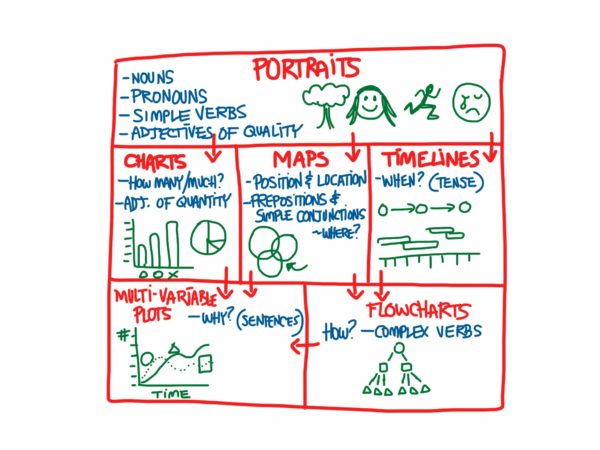Everyone can draw, but most people don’t know how to draw. When we’re learning to print, our teachers don’t just tell us to reproduce the letter R or else, they show us how to pull it off. Where should our #2 pencil start on the paper? Where should it stop? Where should the bust of the R come back to smack the spine? How far should the second leg thingy stick out? It’s not so much that kindergarten kids can’t print letters (a skill issue); it’s that they don’t know how to print letters (a technique issue). But we teach them how to print, how to write, how to craft sentences with subjects and predicates and nouns and verbs. We train them in the fine art of verbal grammar over the course of twelve intensive years. But wait, this isn’t about them. It’s about us. I learned how to employ verbal grammar. You learned how to employ verbal grammar. And, Dan Roam insists, you can learn visual grammar too.
You can learn how to draw.
I’ve referenced Roam’s brilliant book, Blah Blah Blah, before, and I’m going to do it again. Because what Roam gives us, over the course of his manuscript, is a simple introduction to visual grammar. I’ve recreated one of his charts here:  When most people say, “I can’t draw,” they really mean, “I don’t possess the skill to draw a dog lying at his master’s feet by a roaring fireplace in a rustic cabin with pine trees swaying in the snowy wonderland just outside the window.” Well, I’m an artist and I couldn’t draw that either. But who cares? Producing art and drawing are not the same thing. The real issue is, can you communicate your idea? Or, as Dan Roam would counsel, can you draw your idea when mere words don’t work? Roam’s crash course in visual grammar will get you started by helping you know what kind of picture to draw depending on what kind of idea your’e trying to communicate. The red arrows also show you which pictures combine to form other pictures (a flowchart is a map + a timeline). But there’s more! Here are the go-to pictures I draw when I’m trying to help someone “get” my idea (click on it to study a bigger version):
When most people say, “I can’t draw,” they really mean, “I don’t possess the skill to draw a dog lying at his master’s feet by a roaring fireplace in a rustic cabin with pine trees swaying in the snowy wonderland just outside the window.” Well, I’m an artist and I couldn’t draw that either. But who cares? Producing art and drawing are not the same thing. The real issue is, can you communicate your idea? Or, as Dan Roam would counsel, can you draw your idea when mere words don’t work? Roam’s crash course in visual grammar will get you started by helping you know what kind of picture to draw depending on what kind of idea your’e trying to communicate. The red arrows also show you which pictures combine to form other pictures (a flowchart is a map + a timeline). But there’s more! Here are the go-to pictures I draw when I’m trying to help someone “get” my idea (click on it to study a bigger version): I hope my descriptions help you understand what kind of picture to draw and when (how to draw an idea). But honestly, when I’m working on a difficult concept I often end up test flying several diagrams before landing on the one that makes it really pop. Now you have some basic tools that help you know how to draw your idea. And here’s Dan Roam’s book, which is worth every penny:
I hope my descriptions help you understand what kind of picture to draw and when (how to draw an idea). But honestly, when I’m working on a difficult concept I often end up test flying several diagrams before landing on the one that makes it really pop. Now you have some basic tools that help you know how to draw your idea. And here’s Dan Roam’s book, which is worth every penny:
